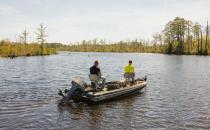Cuts to clean water protections threaten Chesapeake Bay restoration
In April 2020, the prior administration’s so-called Navigable Waters Protection Rule stripped federal Clean Water Act safeguards from wetlands and streams that have been protected by the Act for more than four decades. Citizens, local governments, and states rely on those protections to maintain the health of waterways; preserve sensitive, flood-absorbing wetlands; and ensure clean water for drinking, fishing, and swimming in communities across America. By putting small streams and wetlands in danger, the 2020 rule also threatens downstream waters, like the Chesapeake Bay, that ultimately receive upstream pollution.
The Chesapeake Bay watershed spans more than 64,000 miles in six states–Virginia, Maryland, Delaware, West Virginia, New York, and Pennsylvania–and the District of Columbia. Many of Virginia’s iconic rivers are major tributaries of the bay, including the James, York, Rappahannock and Potomac rivers. The Chesapeake Bay is a cherished part of the heritage and culture of the Mid-Atlantic region: it provides fish and wildlife habitat, supports a vibrant seafood industry, protects against flooding, and delivers myriad opportunities for recreation.
“The importance of the Chesapeake Bay to this region cannot be overstated, so the fact that the prior administration would leave it open to pollution boggles the mind,” said Attorney Jonathan Gendzier, who focuses on clean water work in SELC’s Virginia office.
Sadly, the bay has been the victim of compounding harms—overuse of fertilizers, stormwater and sediment runoff, climate change-induced sea level rise, and wetland destruction by development, to name a few. But hard work over decades, by all levels of government and by ordinary citizens who use and love the Bay, has notably improved the Chesapeake’s health.
The Trump-era rule, however, stands to undo that progress and undermine Chesapeake Bay recovery. In Virginia alone, hundreds of thousands of acres of wetlands in the Chesapeake Bay watershed are put at risk by the rule. By leaving protection of critical streams and wetlands to be decided on a state-by-state basis, the rule means that even Virginia’s relatively strong stream and wetland protections will not protect the bay. Because other states have weaker laws and more-polluted waters flowing into the Chesapeake, the rule’s removal of federal protections jeopardizes improvements in bay water quality, seagrass acreage, and fisheries seen as a result of decades of hard work.
Hundreds of thousands of Americans spoke out against the 2020 rule when it was proposed.
“We need strong federal clean water protections for the health of our families, communities, and the places we love the most, like the Chesapeake Bay,” said Kelly Moser, senior attorney and leader of SELC’s Clean Water Defense Initiative. “Our communities and businesses rely on clean water, and we need the agencies to urgently repeal the unlawful removal of federal clean water protections,” said Moser.

